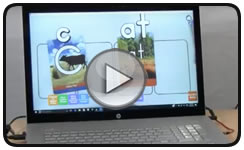We are so excited to be taking over
Target Teachers today! If that's new to you,
Target Teachers is an Instagram account for educators who loooove Target - which should include about 98.9879% of you.
I'm always looking in the Target Dollar Spot for therapy activities. These inflatable dice looked like a lot of fun! I'll be sharing with you how to play a life-sized game with them, and it only takes about 7 minutes to set up (with 5 of those minutes being blowing up the dice)! So for about 2 minutes of prep and less than $10, I made a game that several of my students called "the best ever!"
Requirements:
* inflatable dice - 4 10-inch dice come in the $5 pack from Target
*
sidewalk chalk - the sidewalk chalk is also from Target - I bought it in the toy section. It has a holder for people who don't like sidewalk-chalk-dust fingers, like me.
* a clipboard for data pages
* cards for each student. All of my cards are on a binder ring. These artic cards are from
Gold Country SLP. Each student was responsible for carrying and flipping through their own cards.
Optional: an
IKEA cart to hold everything
To set up:
* go outside, use the existing sidewalk squares or hopscotch squares for game squares, and write START in the first block and END in the last block.
Seriously, it's that easy. I mean, you could go all out and decorate squares and add go forward and move back spaces, but it's not necessary. It would be really cute, but I only used START and END, and the game was a hit.
After a student practices a skill, the die is rolled and the student moves that many spaces forward. That's it. And the kids love being the actual game!
I did learn a few things.
1) One of the inflatable dice had a hole that I could never quite completely cover, so only 3 of the 4 dice worked. If this is a concern, buy more than one package of dice.
2) The dice are pretty round when blown up and do roll more than I thought they would.
2) The two days I did this were pretty windy. I ended up having the students toss the dice to me as I stood about a foot away. I twirled the dice, tossed it back, and whatever number their right thumb was on was the number they "rolled".
3) Of course, one student will roll all 6's and be the first one through. To slow that down, the students had to roll the exact number to get to the END. So if they were two spaces away and rolled a 4, they couldn't move and had to continue to take turns until they rolled a 1 or 2.
4) And to add to that, one student will be lucky and finish quickly. I had my students continue to take turns and give their rolls to another student. IDEA: You could use this for behavior, as in having the finished student give their roll to the quietest student, the one standing in their space the whole time, etc.
5) If you need to stretch out the game, students could move backwards. So if a student needs a 2 to get to the END and rolls a 4, they have to move BACK 4 spaces.
After we played the game, students wanted to play it again, said it was the best game all year, and asked to play it the next session. I sincerely hope this helps your students!













































